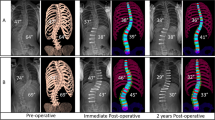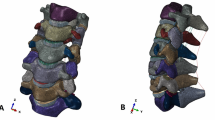Abstract
Spinal stenosis can be found in any part of the spine, though it is most commonly located on the lumbar and cervical areas. It has been documented in the literature that bilateral facetectomy in a lumbar motion segment to increase the space induces an increase in flexibility at the level at which the surgery was performed. However, the result of bilateral facetectomy on the stability of the thoracolumbar spine has not been studied. A nonlinear three-dimensional finite element (FE) model of thoracolumbar T11–L1 was built to explore the influence of bilateral facetectomy. The FE model of T11–L1 was validated against published experimental results under various physiological loadings. The FE model with bilateral facetectomy was evaluated under flexion, extension, lateral bending and axial rotation to determine alterations in kinematics. Results show that bilateral facetectomy causes increase in motion, considerable increase in axial rotation and least increase in lateral bending. Removal of facets did not result in significant change in the sagittal motion in flexion and extension.





Similar content being viewed by others
References
Bernick S, Cailliet R (1982) Vertebral end-plate changes with aging of human vertebrae. Spine 7:97–102
Brinckmann P, Grootenboer H (1991) Change of disc height, radial disc bulge, and intradiscal pressure from discectomy. An in vitro investigation on human lumbar discs. Spine 16:641–646
Brown N, Saputa C, Black J (1981) Young’s modulus of living human bone. Transaction of the orthopaedic research society, 27th annual meeting, vol. 6, pp. 41
Chazal J, Tanguy A, Bourges M, Gaurel G, Escande G, Guillot M, Vanneuville G (1985) Biomechanical properties of spinal ligaments and a histological study of the supraspinal ligament in traction. J Biomech 18:167–176
Dai L (1998) The relationship between vertebral body deformity and disc degeneration in lumbar spine of the senile. Eur Spine J 7:40–44
DePalma AF, Rothman RH (1970) The intervertebral disc. W.R. Saunders, Philadelphia
Epstein NE (1995) Evaluation of varied surgical approaches used in the management of 170 far-lateral lumbar disc herniations: indications and results. J Neurosurg 83:648–656
Garrido E, Connaughton PN (1991). Unilateral facetectomy approach for lateral lumbar disc herniation. J Neurosurg 74:754–756
Giles LGF, Singer KP (2000) The clinical anatomy and management of thoracic spine pain. Butterworth, Oxford
Goel VK, Weinstein JN (1990) Biomechanics of the spine: clinical and surgical perspective. CRC Press, Boca Raton
Goel VK, Kim YE, Lim TH, Weinstein JN (1988) An analytical investigation of the mechanics of spinal instrumentation. Spine 13:1003–1011
Goel VK, Park H, Kong W (1994) Investigation of vibration characteristics of the ligamentous lumbar spine using the finite element approach. J Biomech Eng 116:377–383
Haut RC, Little RW (1972) A constitutive equation for collagen fibres. J Biomech 5:423–430
Keaveny TM, Morgan EF, Niebur GL, Yeh OC (2001) Biomechanics of trabecular bone. Annu Rev Biomed Eng 3:307–333
Kumaresan S, Yoganandan N, Pintar FA, Maiman DJ (1999) Finite element modeling of the cervical spine: role of intervertebral disc under axial and eccentric loads. Med Eng Phys 21:689–700
Kunogi J, Hasue M (1991) Diagnosis and operative treatment of intraforaminal and extraforaminal nerve root compression. Spine 16:1312–1320
Kurowski P, Kubo A (1986) The relationship of degeneration of the intervertebral disc to mechanical loading conditions on lumbar vertebrae. Spine 11:726–731
Lavaste F, Skalli W, Robin S, Roy-Camille R, Mazel C (1992) Three-dimensional geometrical and mechanical modelling of the lumbar spine. J Biomech 25:1153–1164
Lee KK, Teo EC (2004) Effects of laminectomy and facetectomy on the stability of the lumbar motion segment. Med Eng Phys 26:183–192
Malmivaara A (1987) Disc degeneration in the thoracolumbar junctional region. Evaluation by radiography and discography in autopsy. Acta Radiol 28:755–760
Malmivaara A, Videman T, Kuosma E, Troup JD (1987) Facet joint orientation, facet and costovertebral joint osteoarthrosis, disc degeneration, vertebral body osteophytosis, and Schmorl’s nodes in the thoracolumbar junctional region of cadaveric spines. Spine 12:458–463
Markolf KL (1972) Deformation of the thoracolumbar intervertebral joints in response to external loads: a biomechanical study using autopsy material. J Bone Joint Surg [Am] 54:511–533
Panjabi MM, Oxland TR, Lin RM, McGowen TW (1994) Thoracolumbar burst fracture. A biomechanical investigation of its multidirectional flexibility. Spine 19:578–585
Pintar FA, Cusick JF, Yoganandan N, Reinartz J, Mahesh M (1992) The biomechanics of lumbar facetectomy under compression-flexion. Spine 17:804–810
Robin S, Skalli W, Lavaste F (1994) Influence of geometrical factors on the behaviour of lumbar spine segments: a finite element analysis. Eur Spine J 3:84–90
Sharma M, Langrana NA, Rodriguez J (1995) Role of ligaments and facets in lumbar spinal stability. Spine 20:887–900
Shirado O, Kaneda K, Tadano S, Ishikawa H, McAfee PC, Warden KE (1992) Influence of disc degeneration on mechanism of thoracolumbar burst fractures. Spine 17:286–292
Shirazi-Adl A, Ahmed AM, Shrivastava SC (1986) Mechanical response of a lumbar motion segment in axial torque alone and combined with compression. Spine 11:914–927
Teo EC, Ng HW (2001) First cervical vertebra (atlas) fracture mechanism studies using finite element method. J Biomech 34:13–21
Vahldiek MJ, Panjabi MM (1998) Stability potential of spinal instrumentations in tumor vertebral body replacement surgery. Spine 23:543–550
White AA III, Panjabi MM (1990) Clinical biomechanics of the spine. 2nd edn., Lippincott, Philadelphia
Wu HC, Yao RF (1970) Mechanical behaviour of the human annulus fibrosus. J Biomech 9:1–7
Yamada H (1970) Strength of biological materials. In: Evans FG (ed.), Williams and Wilkins, Baltimore
Zander T, Rohlmann A, Klockner C, Bergmann G (2002) Effect of bone graft characteristics on the mechanical behaviour of the lumbar spine. J Biomech 35:491–497
Zander T, Rohlmann, Klockner C, Bergmann G (2003) Influence of graded facetectomy and laminectomy on spinal biomechanics. Eur Spine J 12:427–434
Author information
Authors and Affiliations
Corresponding author
Rights and permissions
About this article
Cite this article
Qiu, TX., Teo, EC. & Zhang, QH. Effect of bilateral facetectomy of thoracolumbar spine T11–L1 on spinal stability. Med Bio Eng Comput 44, 363–370 (2006). https://doi.org/10.1007/s11517-006-0048-y
Received:
Accepted:
Published:
Issue Date:
DOI: https://doi.org/10.1007/s11517-006-0048-y




